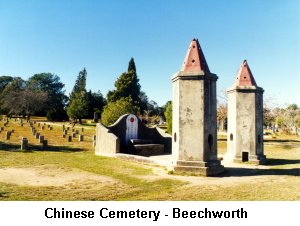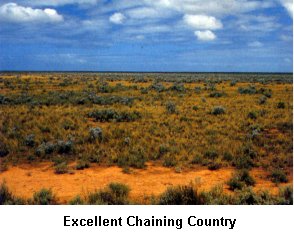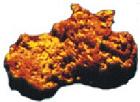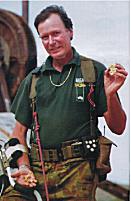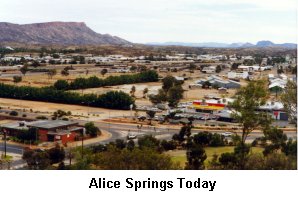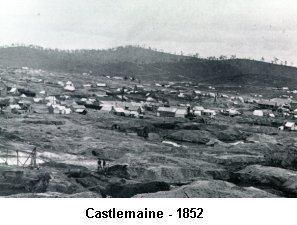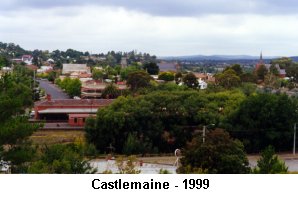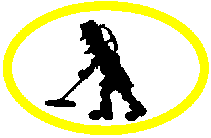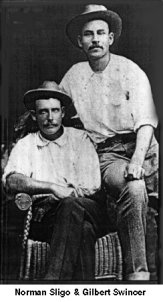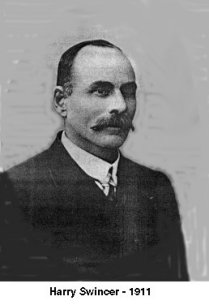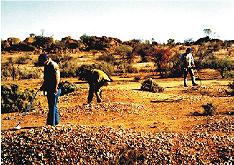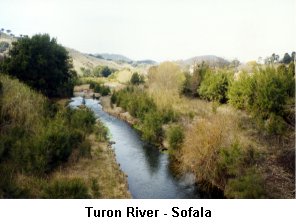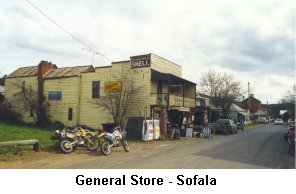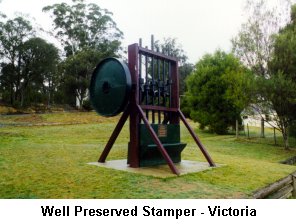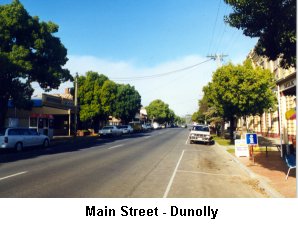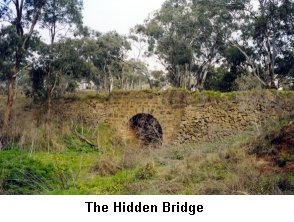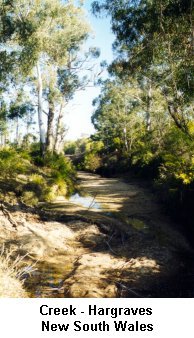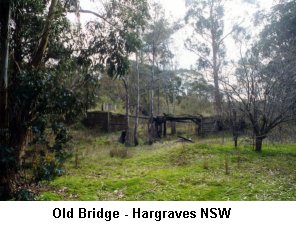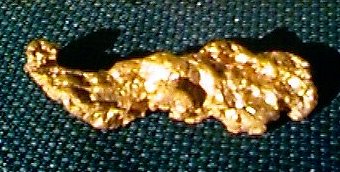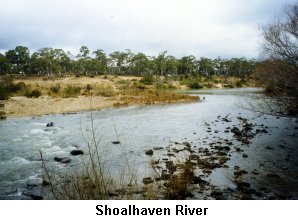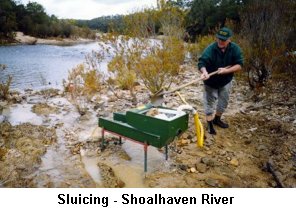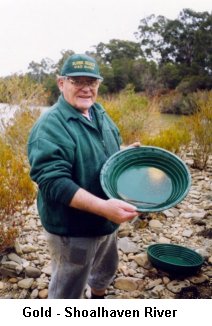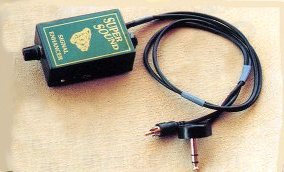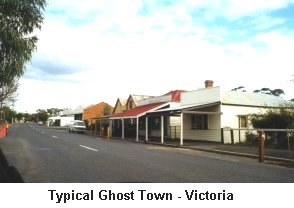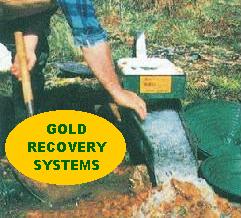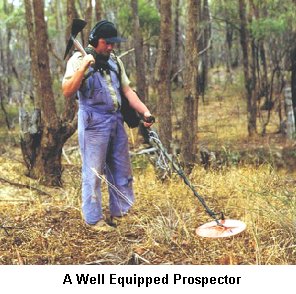
| September 1999 | |||||||||||||||||||||||||||||||||||||||
|
|||||||||||||||||||||||||||||||||||||||
Contents
|
|||||||||||||||||||||||||||||||||||||||
| 1. EDITORIAL One of the most fascinating features of visiting the goldfields is meeting the local characters that abound in rural areas throughout Australia. To visit and "yarn" (talk) with these characters is an enormously rewarding experience. So many of these people display a persona that is unique in the world. Most are not well travelled, and some have not even left their local patch on this earth, but they possess a sharpness and knowledge and understanding of their local areas that makes most of us mere mortals pale into insignificance in the humanity stakes. Their dress is somewhat eccentric, their demeanour unusual, but their local knowledge is without bounds and stretches back incredible distances into the past. In many instances they are simply living treasures. As you visit gold areas in this country, seek them out, and with a displayed humbleness ask for advice, and you will be amazed at the flow of information and understanding that you will gain from such a meeting. I was sharply reminded of this when visiting Sofala recently and had occasion to seek some advice from the locals about gold. Being directed to the general store I approached the owner, a slim sprightly woman, certainly the other side of her three score and ten years, and wearing a hat that was fashionable perhaps in the 1930's, as it certainly looked that old. The mind however, was still as sharp as a tack, and the information that poured forth from this delightful woman was more than I could have hoped for. I didn't ask her name, and I didn't need to. I simply quietly savoured the minutes she graciously gave me and took in all the information provided. I was charmed by the simplicity of the uniqueness of her character. On reflection she is but one of many such souls in this vast land. Enjoy them when you meet them and be enriched. Editor Email: [email protected] All material in this magazine is copyright and may not be reproduced in any part or form whatsoever without written permission from the publisher.
|
|||||||||||||||||||||||||||||||||||||||
|
2. THE BUCKLAND RIOT by Craig Wilson The Ovens Buckland area of northeastern Victoria was a large and productive area for gold seekers. From the early 1850's Victoria had been ablaze with new and exceptionally productive gold finds and the fledgling colony was finding its feet and expanding rapidly. Government infrastructure being difficult and slow to be put in place was a major factor in the lawlessness and hardships suffered during that era. The Ovens goldfields stretched over large distances with several towns supporting the diggers in their endeavours. Beechworth, was one such town, and it was near here that the Buckland riot against the Chinese took place during July 1857. It was a tragic and vile exhibition of organised thuggery. The Chinese were at the Ovens in numbers. There were at least 2,000 Chinese working the diggings that Europeans had abandoned, moving on to easier gold and obviously not taking all the gold from an area. In the Buckland region the "Celestials", as they were known, outnumbered the whites by between three and five to one. Resentment grew, as it became known that the Chinese were getting good gold from the old diggings, and opposition to their unwanted presence was growing.
There had been some previous agitation amongst the Europeans to rid the gold fields of the Chinese, and the two local police officers had been hard pressed to diffuse a number of previous confrontations. They had called for re-enforcements, but they had not arrived, and the situation was quickly deteriorating. On 4th July 1857 about 40-50 miners, who intended to clear the Chinese from the gold fields, held a meeting. Somewhat liquored up and armed with clubs, swords, knives, and some rifles they moved to the Chinese encampment at Lauder's Flat. Adopting an aggressive stance while standing off, the Chinese were instructed to abandon their positions. A lone police officer stood between the mob and the Chinese. His efforts to preserve peace were in vain. Panic quickly set in and taking what possessions they could the Celestials retreated en masse to the river and made their way down stream where other Chinese were camped. The rioters, still under some control at this time, looted the camp and burnt about 50 tents and 2 stores. Other property was thrown into the river. Not satisfied with this, the diggers followed the fleeing Chinese down the river to Stony Point where warning had been given and about 30 tents were torched. At this time the rioting diggers were joined by others hell bent on moving the Chinese off the diggings. The camps they had been occupying had been left in a total shambles, all the tents were burnt, property looted and tools broken. Very little was left intact. Stragglers were caught and viciously bashed, and robbed. Some were left with terrible wounds. As the pursuit continued downstream, more Chinese were forced to flee as their tents were looted and burnt, and those resisting were set upon and robbed and bashed.
The mad fury of the rampaging mob was reaching a crescendo at the main Chinese camp at Lower Flat. There were over 200 camped here and with some warning the flight continued. It was here however that the worst atrocities occurred, when some Chinese resisted. Bashings, woundings, and violent robberies occurred here. What could not be burnt was thrown into the river, and other property destroyed. As the Chinese were fleeing, more respectable whites encamped along the river, moved to intervene and curtail the mob, only to be set upon themselves. The mob itself displayed some degree of restraint, as not all of those participating were involved in the bashings, and many instances occurred where vicious bashings and robberies were curtailed or interrupted by other elements within the mob. It was a disorganized rabble. The fleeing Chinese were fast approaching the only ford over the Buckland River, and this was negotiated by a large fallen tree, that lay across the river. It was the only place the river could be crossed safely, and the narrow approach encouraged the mob to quicken the pace to maximize damage on the fleeing Chinese. A group of diggers aware of the approaching mayhem and observing at the crossing moved to allow the Chinese to escape, and stood in a line between the fleeing Celestials and the mob, allowing an orderly and safe crossing over the river. During this last pursuit towards the river the Chinese had fired rifles towards their pursuers, wounding three diggers, and slowing the mob, giving more time to flee across the river in safety. Not all the Chinese escaped unscathed. Some drowned and some died of their wounds. Exact numbers are not recorded, but in the eight-mile pursuit, the number of deaths and other casualties could be properly described as moderate. Police re-enforcement's from Beechworth arrived two days later, with a large group of mounted troopers under the command of Inspector Burke. Three weeks later more re-enforcement's arrived. Order was restored. The identified rioters were arrested and charged with a variety of serious charges. Not all were convicted, as witnesses particularly from the Chinese side were reluctant to give evidence, fearing reprisals. In fact only one was convicted of riot and a handful convicted of the lessor charge of unlawful assembly. Those convicted were all gaoled. An inquiry was held and the Chinese made a claim for compensation to the government authorities. Although the claims were perhaps somewhat inflated, compensation was ordered, but the Chinese received very little of these funds. They were not misappropriated, they were simply not paid. From this point in time the Chinese received greater protection from authorities in Victoria with Chinese speaking liaison officers being appointed to deal with the Celestial diggers. The wrong had, to a degree been put right.
|
|||||||||||||||||||||||||||||||||||||||
by Jim Foster While on our trip to Western Australia, Cheryl and I have shared lots of adventures. But while we were there we found that finding gold by chaining was a most effective method, especially in the Leonora area. Chaining is to drag a chain behind you to leave a mark on the ground as you detect for gold. By leaving a drag mark behind you it is then easy to return across the patch of ground using the first chain mark as a guide. In this way a gold bearing patch of ground can be "gridded" so as you can be sure of finding all the gold nuggets that are there. Some people prefer to use pegs driven in the ground to mark where they want to go or where they have been. Others will go to the extreme of using pegs and cord to guide them. I prefer to use the chain method. Done properly, very little gold will be missed. Many people think they can get all the gold off a patch by simply wandering, and sometimes you can. But more often you can't. As an example: we struck a small patch recently where we got eleven nuggets, the biggest being nine grams. Total weight off that patch was a bit under an ounce. We gave that site a good going over then went back and did it again a few days later for only one more small nugget. Deciding to chain it I selected for the lower part of the heavily mineralised slope our new 18" double D coil from Coiltek. The main reason for the larger coil was I knew the ground low on the slope to be deep, averaging about 18" to cap-rock.
WHEN TO CHAIN A PATCH Almost any patch of ground where you find gold is worth chaining. The patch mentioned above was on ground that had been hammered for years. Old and new dig holes covered that slope. Some of the nuggets were even found where someone else had scratched the ground but decided it was just a hot-rock or hot ground. It is essential to chain where you have found a number of nuggets on untouched ground. Even chaining old diggings where you have found several nuggets can be worthwhile. Without setting parameters and searching every inch of that ground you will miss nuggets. We use the Minelab SD2200D as our preferred detectors. Cheryl uses the standard 11" double D coil that comes with the detector, mainly for the lighter weight. As a standard coil I now use the 15" double D coil from Coiltek. When we encounter lightly mineralised ground we switch to the monoloop coils for extra sensitivity. But as a rule the ground we work is heavily mineralised and requires a double D wound coil to give the depth and the sensitivity required. I have found the Coiltek double D coils to be extremely quiet thereby allowing even the faintest signal to be heard. USE THE BEST YOU BUDGET WILL ALLOW Coupling the Coiltek coils with SD2200D detectors gives us the very best and latest in gold detectors. This gives us a decided advantage over older or conventional detectors. You need every edge you can get if you want to find the gold left behind by others. But having said that I must point out that chaining can also be very successful using conventional detectors. HINTS There is an old saying about detecting, "It's not how much ground you search, but how well you search the ground." This says it well. Too many people go to all the trouble of setting up and chaining a patch then walk away leaving gold behind. If you look at the patch you are to search then set out to search it as quickly as possible, you will leave gold behind. Take your time. Keep your runs (chain marks) no more than a metre apart. Overlap your sweeps. A good rule is to make three sweeps of your coil for every step forward. But keep the steps short, and your sweeps low and slow. Brush your coil on the ground if you can. It won't hurt the coil if you rub it on the ground, it is protected by a skid plate and skid plates are cheaper than gold nuggets lost. Try not to knock the edge of your coil into large rocks. Repeatedly hitting rocks WILL damage your coil. CLEAR THE GROUND By that I don't mean hire yourself a bulldozer or even to dig out all the trees and bushes. Many good detecting spots have a good deal of rubbish scattered on them. In Western Australia every patch has its rubbishy spot, mostly they are the actual campsites of the original prospectors. Often this rubbish covers good gold. One old tin can will shield an area at least a metre in diameter so, many cans mean many metres missed. Pick up any cans you find on the patch before you begin. Any more rubbish you find while chaining toss back on the ground you have already done. As these cans are very old some of them will have rusted into small pieces, a good strong magnet will clean these bits up and ensure you leave no ground unsearched. If you wish to do the right thing bag all the rubbish and dispose of it properly, and remember, the old timers had a good excuse for not hauling their rubbish home, you don't.
DIGGING A NUGGET Marking a nugget with your pick while digging can severely reduce the price of your nugget. Nice jewelry gold can fetch up to 50% above bullion price, but hit it with your pick and the best you will get is bullion price. When you get a signal first scrape away the surface soil. If the target is still in the ground carefully centre the target. Then, dig around and well away from the target. If it is a large and deep target you may have to enlarge the hole to avoid hitting it. Use the spike of your digger to lever up the loosened soil in the centre of your hole and free the gold. Before filling the hole in check both the hole and heap for other nuggets. It isn't rare to find two nuggets in one hole. Many people have walked away and left another nugget behind.
Your detector is an expensive piece of equipment, look after it.
When digging a target set your detector down UPWIND of where you are going to dig. Most detectors are well sealed these days but the extremely fine dust found in the goldfields WILL sooner or later find its way into your control box and switches.
Follow these simple guide lines for chaining for gold and you will increase your
finds. All it takes is patience. One person I know takes the attitude that "I know there is a nugget in that ground and now I'm going to find it." He usually does.
I know that using the chaining method on this trip for us has been very rewarding.
by Katherine Knight Ever since the failed and fatal expedition seeking Lasseter's Reef west of Alice Springs in 1930, the expedition and the eventual outcome have been the subject of conjecture and derision. The truth pertaining to Lasseter may never be known, but Fred Blakeley, the expedition leader was in no doubt that Lasseter was indeed not telling the truth. Some ten years after the expedition Fred Blakeley provided information to Mary Mansfield, a journalist of some note at the time, regarding his deep suspicion of Lasseter and the whole scenario. His reason for providing this information was essentially to "set the record straight", but out of respect for Lasseter's widow and the four children, he never completed the manuscript. He died in 1962. Fred Blakeley was a bushman. He had spent a good deal of his time in the Australian outback and was very experienced. When he interviewed Lasseter in Sydney in 1930 he considered that there just might be sufficient credibility in the story to accept it. He tempered his comments after the interview with the proviso that the story may be fabricated. In any case he was offered and accepted the position of expedition leader.
The expedition members were diverse and in the main experienced.
Blakeley as leader. George Sutherland was a prospector and miner.
Phillip Taylor was the driver and engineer, and was highly competent.
Errol Coote as pilot and Captain Blakiston-Houston - explorer and ADC to the Governor General. He was an experienced soldier.
On another occasion Lasseter pointed to a large cave up the side of an escarpment, and proclaimed that he had slept there. It was far too high and steep to be reached by humans, and was probably only ever inhabited by eagles. Blakeley and the others knew he was lying on this occasion. At a camp one night Lasseter proclaimed that he had swung a hammock between two nearby trees. Blakeley knew the trees were only a few years old and certainly not 30 years old as they would have had to be. When challenged he stated that the trees were very similar and perhaps not necessarily the actual trees. What created the most suspicion was the fact that large mountains were not recognised by Lasseter. For a man who had allegedly traversed this country, such prominent solitary features should have been talked about and easily recognised. It was obvious to all that Lasseter had never been in this country before. Lasseter and Blakeley on one occasion climbed a large escarpment to take bearings using a sextant. Blakeley used the instrument and when he stated the figures, Lasseter proclaimed them to be exactly as they were some 30 years before. He did not record these figures and later that night was unable to recall them, which necessitated the readings being done again the next day. Not a particularly credible action on his part. During the initial interview and even while at Alice Springs Lasseter did not mention the aboriginal population. This was indeed strange, as the country west of Alice Springs was full of indigenous inhabitants. Lasseter clearly had never had contact with aboriginals before in this area. Additionally he had no idea of the flora and fauna of the area, although he was supposed to have been through the country before for many months. He could not use a sextant, but had allegedly taken bearings using a sextant years before.
Coupled with this Lasseter continually changed the story of his previous exploits into the red centre where he allegedly found his legendary reef. He alleged Harding, a surveyor found him, and then the story included being found by an Afghan camel driver, and subsequently a dingo trapper. Coupled with this although Blakeley was never aware of this fact, Lasseter was in a juvenile reform institution in Victoria at the time he was allegedly finding his lost reef. Finally Blakeley decided that the whole story and Lasseter was indeed a fraud and he concluded the expedition upon this realisation. He acted entirely properly. However, upon his return to Sydney, when he reported his reasons for ending the expedition, it was he who was derided and not Lasseter. A clear example of common sense being overridden by a lust for gold. Some 4 years later Blakeley met Buck in Sydney. Buck was the man who allegedly found Lasseter's remains. After speaking with Buck, Blakeley formed the opinion that Buck was not telling the truth, as his story was flawed. Although Buck never acknowledged the story of finding and burying Lasseter was fabricated he asked Blakeley to remain quiet for a few more weeks, when Blakeley put to him that the story was in fact fabricated. Rather unusual in the circumstances.
Blakeley believed that Lasseter did not perish in the outback and that he walked out and perhaps commenced a new life again as he had before. Whatever the truth, the legend of Lasseter remains an enigma. A story of gigantic proportions, and one that to this day remains unanswered.
|
|||||||||||||||||||||||||||||||||||||||
|
|||||||||||||||||||||||||||||||||||||||
|
|||||||||||||||||||||||||||||||||||||||
|
|||||||||||||||||||||||||||||||||||||||
|
5. COLOSSAL CASTLEMAINE Sue "Goldie" Reynolds Mount Alexander just a few miles north east of Castlemaine was one of the greatest gold bonanzas the world has ever seen. Gold was officially found in this area on September 8th 1851, when a shepherd on Dr. Barker's Mount Alexander No.1 Run announced in the Melbourne Argus that gold had been discovered there. In fact the shepherd in company with others had been hoarding gold for some time, until discovered by their master. Within a few short weeks there were 3,000 there and within another few months the numbers had swelled to around 40,000. It was from the wealth this gold brought that escalated the opulence of Melbourne town into the 1880's. Major Thomas Mitchell had previously surveyed this area as he surveyed much of Victoria and the south east of South Australia, finding extremely rich pastoral ground, which the government leased, to pastoralists. He did not look for gold, nor did he find it. His primary task was to locate a third major river that was presumed to be somewhere inland, that joined the Murray and the Darling.
Desertions to the gold fields from all walks of life strained the colonies ability to even function as an entity. The master of one ship whose crew had deserted to seek their fortunes inserted the following advertisement in Melbourne newspapers. "SHIP TULLOCH CASTLE
If any of the crew of the above ship, except William Mitchell, will return to their duty, no proceedings will be taken against them, and they will receive the current rate of wages for the run to Bombay. Apply on board, or at the office of James Henty, 11 Little Collins Street, west. 3167 WM. MURRAY Master." One smart ship's master left the ship in the charge of the first mate and with the crew went to the gold fields, dug a large quantity of gold and then he and the crew all returned and sailed home to England.
Governor LaTrobe saw the diggers as a ready source of much needed finance for the colony and it became his intention to double the licence fee to 3 pounds per month to fill the coffers. The fee of 30 shillings was hard enough for many but this doubling of the fee got a resounding and fierce response from the diggers. Meetings resolved to pay no licence fee at all if the 3 pound per month fee was introduced. LaTrobe wisely changed his mind, but the seeds of dissent were sewn. The authorities were seen as off shoots from the aristocratic system that prevailed throughout the British Commonwealth at that time and resentment and disdain of the authorities was well founded. Those without a gold licence were hauled off, often in chains and chained to trees to await the pleasure of the authorities. No wonder there was resentment.
Just how much gold was recovered from the Mount Alexander area is open to conjecture. It will probably never be known, but some facts can be gleaned from the enormous wealth. The first gold escort overland to Adelaide in South Australia carried 94,000 oz. The ruffian element was particularly evident at Mount Alexander, and with reluctant police the miners began to take matters into their own hands. Most were armed and vicious dogs were the order of the day. By 1853, permanent buildings are erected in Castlemaine. A large gaol is built and other government buildings constructed to provide infrastructure. On November 1st Castlemaine is proclaimed a town. Some very fine buildings were erected in Castlemaine, and most are still intact to this day.
During 1855 a large number of public institutions are completed, including the Library and the School of Mines. The Chinese were at Mount Alexander and the surrounding areas in numbers. Although spread out with small groups at each place where diggings were being undertaken their presence was resented. Some of the European diggers agitated against the Chinese and only a short time after the Buckland Riots which was a strong show of force against the Chinese, an anti Chinese riot almost occurred at Golden Point. The intervention of a single police officer who placed himself between the agitated Europeans and the Chinese, saved the day and defused the situation. The Chinese question was often considered and great resentment among the diggers was evident. The imposition of taxes on the Chinese to enter the colony of Victoria and the anti Chinese attitude resulted in about 3,000 Chinese refusing to pay licence fees at Castlemaine and soon the lockups were full of Chinese, who were required to work off their fines. In retaliation the Chinese refused to deal with the European business houses. There was a sharp response from the business leaders supporting the rights of the Chinese. Ironically the authorities displayed considerable tolerance of the Chinese and there are many recorded instances of police and soldiers providing protection for them against brutality and foul treatment. Castlemaine today remains a delightful community with a strong spirit, celebrating its past with prominent displays of historic memorabilia. Gold is still mined there, and surveys are presently being taken with the view of opening up other gold mines.
|
|||||||||||||||||||||||||||||||||||||||
|
|||||||||||||||||||||||||||||||||||||||
|
6. REDCASTLE GOLDFIELD Cheryl Foster One of the richest alluvial goldfields in Western Australia's Eastern Goldfields, Redcastle is located in what was at the time of finding, some of the most hostile country in the world. Summertime temperatures can hover around 40 degrees Celsius for weeks at a time. Late last century when little of the country had felt the tread of steel-shod blucher boots, water was a rare and valuable commodity at the Quartz reef that dipped and crossed the flat. The next morning saw the two men hard at work on their find. They had defined the parameters of the richest ground before marking out their claims. They also had to define the best section of the nearby gold bearing quartz reef. Suddenly they heard horse bells. Hiding in the bushes they watched a group of prospectors ride past. As soon as the party was out of sight the partners hurried after them to ensure they were just passing through. As they cut the tracks of the party they saw, stood up on edge by the horses hooves, a gleaming two and a half ounce nugget of pure gold. The rest of the day was spent dry-blowing and sieving each gully and slope to find the richest ground. That evening a thunderstorm blew up and wet the pair's blankets. As they had moved their camp into the high castle like caves that prompted them to name the spot "Redcastle," the pair decided to hang the blankets out in front of the caves to dry. Next morning they were hard at gold gathering again when they saw a lone rider approach. Watching from behind the shelter of trees they saw the man jump from his horse and pick a lump of quartz from the ground. Even at a distance they could see his eyes follow the line of reef as it snaked across the alluvial flat. He had found the reef.
The newcomer admitted he had tracked the pair to see if they were on gold and wanted a share of the reef. Norman and Harry had little choice if they wanted to keep their find secret until they had their claims pegged. Reluctantly they agreed. The newcomer, named Marsten, then handed over the specimens he had found. The first was a splendid lump of stone about the size of a teacup, all shot through with gold. Marsten's eyes glittered and his hand shook as he took back the specimen, he knew he was onto the richest show he'd ever seen. Marsten swore to secrecy and the men began pegging off five claims plus a "reward claim." That evening Marsten returned to his camp to bring over his gear and to tell Billy Street to bring in a supply of water. Towards evening of the next day Marsten returned with Billy. Getting away from Marsten, Billy reported that eight prospectors had turned up and that two of them were Marsten's mates. The next morning a group of prospectors commenced mining just outside of the marked claims, and before night another lot had arrived. Next day fifty men were hard at work. A veritable cloud of dust hung over the once peaceful hollow and the walls rang to the sound of pick and shovel. Hurrying feet could be heard as more men arrived and dashed about to find a spot to claim while the sound of gravel being swirled in dry metal dishes roared like surf on the ocean shore. Redcastle Mining Centre was a reality that had taken only a few days to transform from the quiet and beautiful surroundings to something that resembled hell itself.
It was an unlucky find for the three Murphy boys. Before they could gather their riches and sail back to Ireland as they planned, all three were dead from typhoid fever. The graves of two of the brothers can still be seen at Christmas Gift mine. The third brother died at Coolgardie. Norman Sligo and party left Christmas Gift and moved further north to prospect the country around Mount Flora. The prospects for a find were good there and they were keen to get back out into new country before others beat them to it. It was a move that was to be well rewarded. In the meantime, their reefing mine at Redcastle attracted a bid of four hundred pounds. Not wanting to be tied down by a claim and having done very well from the alluvial gold they had won they sold out and continued with their prospecting.
|
|||||||||||||||||||||||||||||||||||||||
|
|||||||||||||||||||||||||||||||||||||||
|
|||||||||||||||||||||||||||||||||||||||
|
7. SOFALA YESTERDAY AND TODAY by Claire Jackson The Turon River has its headwaters in Australia's Great Dividing Range, high on the western slopes. It is a lonely and inaccessible area, although a bitumen road now links the larger city of Bathurst with this unique old gold town. Steeped in deep gorges the river has few easily accessible areas where a township could be established, and much needed supplies safely stored for the diggers that were to turn this river into a river of gold some 150 years ago. In February 1851 Edward Hargraves had been prospecting in the area and formed a prospecting partnership with John Lister, James Tom and William Tom junior. Initially this partnership was relatively unsuccessful and after prospecting along the Macquarie River for several weeks without success Hargraves left his partners to their own devices. While Hargraves was gone the remaining prospectors tried their luck in the Lower Turon without success.
Hargraves being a rather brazen man approached the government on 1st April 1851 and presented them with this gold claiming the reward as the discoverer of gold in Australia., and was paid a substantial reward which he refused to share with his former partners. Others now were finding gold in the Turon River with regularity and with Hargraves alleged find the publicity led to a number of diggers travelling to the area to test their skills. By the middle of June the area was being swamped with gold seekers and the rush was on in earnest. On a small patch of ground a small township began to grow. It was one of the few areas where buildings could be erected along the Turon's steep banks, and this small township was soon called Sofala, after an area in Mozambique, identified as the legendary land of Ophir where King Solomon gained his wealth. The population in the region was soon well past 2,000. As this was the first gold that had been discovered in the colony of New South Wales, legislation was quickly put into place requiring all diggers to pay a monthly licence fee of 30 shillings. The government appointee, required to collect the fee became quickly bogged down with the work load and was sanctioned for allowing the diggers to dig enough gold to pay for their first licence. The Government of the day, considered this arrangement totally unsatisfactory. It would be fair to say that the Turon goldfields were no different from other gold fields in their interpersonal relationships. The "Quicksilver Queen" quickly established herself as a professional lady of the night who had an insatiable reputation for taking the miners hard earned gains. Gold buyers were known to cheat in their calculations somewhat and take advantage of the diggers with lessor educations. Costs were alarmingly high, and the government moved to outlaw profiteering on gold claims that were procured for some 30 shillings and sold for enormous sums.
In one week a party of 6 recovered 157 oz. Similar stories abounded in this location. Many diggers found that digging into the sides of the creek banks recovered more than sufficient paying gold, with one group finding a 32 oz nugget in this manner. One fabulous story from this era, relates to a miner who upon finding the water from the river too dirty to drink, sunk his shovel into the ground to seek a fresh pool and showered his boots with gold flecks that were sitting just below the surface of the dirt. Another told of a man whose horse slipped on a slippery slope and threw the rider dislodging a large rock that concealed a large nugget that weighed 74 pounds. Gold dust was so plentiful in some locations that small children would follow wheelbarrows and when they hit a rut of stone and spilt some of the wash dirt the children would collect the dirt and wash it themselves making a handsome living from this practice. Another party considered his claim to be washed out and sold it for 600 pounds only to find that the experienced purchasers gained 50 oz on their first day of operations. Many similar stories drench the recorded history of this location. The Turon was a treacherous place to work. It was not always a peaceful running stream, with flash floods and drowning a common occurrence. Like most goldfields life was harsh. Some of the most spectacular gold finds were as follows. 1851
Jul 15 - 157 oz in 9days 1852
May 12 - 57 oz nugget 1853
Jan 2 - 28 oz in 1 day The Turon during those early days was constantly flooding and by April 1852 almost 70% of the diggers had moved away from the area to the more reliable Tambaroura diggings, where water was not so plentiful but the ground was easily worked. By the end of 1852 large numbers of diggers had moved onto the Beechworth diggings in Victoria. The threat of excessive Government regulation was taking its toll on the diggers.
The tourist trade is brisk, and fossickers and locals still sluice and pan for gold, especially after heavy rain when the river replenishes its gold reserves. It is indeed a unique historical place and one that will continue to remain an untouched jewel.
|
|||||||||||||||||||||||||||||||||||||||
|
|||||||||||||||||||||||||||||||||||||||
8. FLECKS ! - Glints from here and there
|
|||||||||||||||||||||||||||||||||||||||
|
|||||||||||||||||||||||||||||||||||||||
|
9. GOING AFTER GOLD by Walter Forsythe "Strewth mate" Wack said, "Every time we organize to go get some yella stuff why can't we agree on a decent spot? You always reckon you know the best spots. Why can't we go to my spots for a change?" I was not taken back by Wack's comments, as he always wanted his way, and usually got it. We had been mates since our school days, and now both being in our forties we were still good mates, and we both shared a love of the yellow metal and enjoyed detecting when time permitted. These days we have wives and kids to look after, so getting together regularly was somewhat difficult. To appease the savage beast I simply yielded to him and said, "Wack, you go where you like. But if we don't get any gold, you can expect a good smack around the ears. OK?" He grinned and the day was set. Wack (real name Robert) had always been a boisterous character, and in his school years had been somewhat delinquent, and some of his behaviour at that time had been a little over the top, and some considered him a little "whacko". That nickname was his and it suited him. Over the years it was shortened to Wack or Wak, and it stuck. Well all his mates called him that, but not his trouble and strife (wife) or his ankle biters (kids). I never really had a nickname, just the Walter shortened to Wal. So it was that we set off from my house in Bendigo to Wack's spot, wherever that was to be. We loaded up quite early. It was a cold winter's day, and Wack had brought his faithful Blue Healer dog with him. Deefer was as faithful a companion as you could find. He went everywhere with Wack. Why Deefer? Well D is for dog, so rather than call him just dog he called him Deefer, but he still called him Dog in reality. With no idea where we were going, I quietly asked our destination. All I got from Wack was a large cheesy grin and silence, as he drove on heading west. I knew this country well, and there were a lot of gold sites we could have visited. In fact they were so many I had no idea where we would end up for the day. I resolved to lay back and just wait. Where ever we were going it would still be in gold country.
An hour later we were hopelessly lost in the bush in thick fog, obviously miles from where he had intended we would be. Never the less, we were in gold country somewhere in the hills just west of Dunolly, and I am sure Wack just thought that this stop would be good enough, so he declared, "This is it mate, right to the very spot". He had no idea where he was and neither did I exactly, but his grin said it all. He always made the best of a situation, no matter how bad it was. We dragged out the detectors, hooked up, tuned in and headed off. We decided to work near each other in this fog, as the fog can stay down all day some times, and finding our way back to the ute just might be a little difficult on your own. We are always safety conscious. It seemed a likely spot. Quite a few old diggings that we could see, even if visibility was down to about 50 yards. The flamin' fog was a nuisance. It just hung about and stayed on the ground. I thought it would have lifted about 10 - 11 but it was going to be one of those days. I just knew we were in for trouble. Perhaps it was a sixth sense, but things were about to take a turn for the worse. We had only been detecting for about half an hour when the drizzle started. Slowly at first, certainly not enough to stop detecting, then it grew into a steady slow rain. It just kept coming. We made our way back to the ute and hopped inside. Deefer wanted to hop into the cabin, but Wack convinced him to get into the covered back with a little encouragement. We sat there and talked lots of codswaddle for an hour or two, until it dawned on me that we had crossed a creek coming into this spot. It had been a dry creek bed then. I mentioned this to Wack, and suggested that perhaps we should try and at least head back that far to avoid being trapped on this side with no hope of getting across if this rain continued. "Strewth - yeah" he said, and took off like a Bondi tram heading for that creek crossing just a few hundred yards away.
We talked, enjoyed a beer or two, or three, perhaps four, and wiled away the hours waiting for the creek to lesson the flow. It took an agonising 5 hours. We just sat there in the fog and drizzle and talked. It's amazing what one can find to yarn about in those circumstances. Necessity is the mother of invention, as they say.
No we didn't get any gold that day, so the next time we go, I get to chose the spot. When we got home and unloaded, Wack was just about ready to leave when I slowly approached him and gave him a light smack across the back of his head. "What was that for?" he said indignantly. "For not getting any gold, sport". "Oh, yeah, right." He replied. We both laughed. Gold is an advantage, but the real treasure is the company and friendship of Wack.
|
|||||||||||||||||||||||||||||||||||||||
|
|||||||||||||||||||||||||||||||||||||||
|
WE BUY GOLD GOOD QUALITY NUGGETS REQUIRED TOP PRICES PAID Currently seeking half ounce nuggets and upwards. Gold nuggets sold on consignment 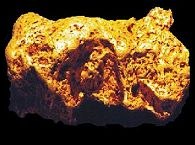
PO Box 258, TANUNDA. SA. 5352 Telephone: (08) 8563 0097 Mobile: 0417 848 910 E-mail: [email protected] |
|||||||||||||||||||||||||||||||||||||||
|
|||||||||||||||||||||||||||||||||||||||
|
10. LOUISA CREEK - HARGRAVES by John Bollmeyer Louisa Creek derived its name from the aboriginal name for the area that sounded vaguely similar to Louisa. Gold was first found there in June 1851 and what a find it was. There was a mission at Wellington that was influential in bringing the faith to the local indigenous population. Some of the young blacks were trained as shepherds, and it was one of these fine young men that found one of the great gold finds in Australia. June is mid winter in Australia and this country can be bitterly cold even in the middle of the day. The aborigine's Anglo Saxon name was Daniel. It was a crisp morning when he came upon an outcrop of rock that was almost pure yellow in colour. He thought this rather unusual and told his employer Dr. Kerr of his find. Upon inspecting the gold, Kerr tried to move the whole block , but it was far too heavy to move. Of necessity it was broken into three smaller blocks. It contained a total of 1,693 ounces of gold. There appeared to be no other gold in the vicinity, so two of the pieces were taken by horse and cart and exhibited publicly, outside the Free Press Office in Bathurst. The Kerr Hundredweight as it was known was sold for four thousand pounds. One of the pieces eventually found its way to London where it was exhibited in the Crystal Palace Exhibition of 1851.
In December 1851 larger nuggets were found near where the Kerr Hundredweight was found. Only 25 yards away a nugget weighing 335 oz. was found. Other nuggets found in this area weighed 88 oz. 42 oz. 218 oz. 42 oz. and 35 oz. By the late 1850's quite a settlement had grown at Louisa Creek. Several stores, some hotels and a post office along with a number of fine churches dotted the landscape. In 1872 Louisa Creek was renamed Hargraves, after the man who had allegedly been the first man to find gold in Australia. The authorities believed that this was the area where Hargraves made his find, and renamed the town in his honour. Louisa Creek was a long way from this find. With the sheer volumes of gold being recovered in Australia restricted the number of diggers at Louisa Creek, simply because the vast gold fields of Victoria were attracting the majority of diggers. One of the first companies to show interest in gold recovery, the Great Nugget Quartz Ridge Crushing Company, took out a lease over a large portion of land. Somewhere near 320 acres of land was leased in 1851, however it required legislation through the New South Wales Parliament to enable company registration. The Great Nugget Vein Company, formed in 1852, was quite successful and at times got 30 oz of gold per crushed ton. It was not always as successful and was sold in 1856, with the new owners installing a new stamping engine. This venture was not successful and the company eventually went into liquidation. When this country was opened up to prospectors again about 2-3,000 diggers arrived and quickly got good gold near the surface. Apparently the company had ignored the auriferous surface gold and the diggers reaped a rich reward. The majority of gold was recovered from Louisa Creek, Meroo Creek and Louisa Ponds Creek. The gold bearing ground here was over 2 yards wide. The Main Axis Reef produced good gold for over 25 years. There were several instances of companies being involved in establishing large tunneling operations, which were essentially unsuccessful. Tucker's Hill had a tunnel built into the side for about 130 yards without success. The cost of this was 40,000 pounds. An expensive exercise in futility. A second tunnel was built nearby at great expense without success.
In 1878 the New South Wales Government enacted legislation to provide grants to companies and individuals to improve gold returns. In 1888 the Big Nugget Gold Mining Company obtained a grant but closed in 1894, achieving only moderate success. By 1914, gold mining from this region had practically ceased. In 1933 extensive surveys were carried out in this area. Nothing eventuated from these surveys. Records of the gold recovered from the Louisa Creek - Hargraves gold fields are some what fragmented and the accuracy is suspect. It was however a significant contributor to the gold wealth of this country. With satellite imagery advancements, increased activity in lease holding arrangements have accelerated exploration licenses in Australia. Geoservices Pty. Ltd. have recently taken out lease holdings in this area covering substantial areas of previously mined ground. At this time there are no plans to actively mine gold in the area, but with the gold price beginning to recover, that policy may change if the reserves are sufficient to economically mine once again. Hargraves today is a small rural community with a strong heart. The population is now about 400. The local Historical Society is moving to preserve of the history of the region. Many of the historical sites are in disrepair and are somewhat overgrown.
|
|||||||||||||||||||||||||||||||||||||||
|
|||||||||||||||||||||||||||||||||||||||
|
|||||||||||||||||||||||||||||||||||||||
|
|||||||||||||||||||||||||||||||||||||||
|
11. STRIKES Recent Finds
|
|||||||||||||||||||||||||||||||||||||||
|
|||||||||||||||||||||||||||||||||||||||
|
|||||||||||||||||||||||||||||||||||||||
|
|||||||||||||||||||||||||||||||||||||||
|
12. SHOALHAVEN RIVER GOLD by Steve McNickle I had heard a lot about the Shoalhaven River and the gold that it allegedly stored and I was somewhat apprehensive and suspicious about the real quantities of gold that could be found there. However as a gold fossicker I have a healthy appetite for gold and have learnt over the years not to close my mind to the stories one hears, just treat them with a degree of caution and make ones own assessment. I had spoken with Martin Marks a number of times and this gold enthusiast had offered to meet me down on the Shoalhaven and show me his sluicing equipment, which he had developed over many years. I was aware of his reputation as a competent fossicker and in particular his ability to pan and sluice for gold. I was also well aware that he had won championship panning competitions and had represented Australia overseas, and it was obvious that he knew what he was about.
When I arrived at the workshop he was experimenting with a venturi to improve the water flow through his sluice boxes. The compulsory demonstration convinced me that what he had perfected would indeed work. We arranged to meet at a location on the Shoalhaven the next day, after consulting a couple of maps and having some drawings made to ensure we were going to the same place. Next day I headed off south along the Hume Highway towards Goulburn and at Marulan turned off the highway and headed southeast towards the designated site some 40 miles further. It was a slightly misty morning with a few showers about and I hoped that in fact Martin had made the trip and not abandoned the weekend because of the weather. I shouldn't have worried, as when I reached the site, there he was, right where he said he would be. I was somewhat relieved. Renewing our acquaintance I tossed my gear into his ute and we headed off south along a private track that accesses the river. By Australian standards the Shoalhaven River is quite a river with a good flow all year round, even in the driest summer. With the headwaters in the Monaro district of the southern tablelands of New South Wales, the river is relatively short, perhaps 100 miles long as the crow flies, but must in actual fact be longer if all the twists and turns are taken into account.
The terrain here could be dangerous. Both sides of the river had steep slopes, but just where we were, there were tracks that four-wheeled drive vehicles could easily navigate. There wasn't much river sand here, but lots of rocks, shale and ironstone, water worn, lots of it. It was here near the iron stone that Martin set up his sluice perhaps only 10 feet from the waters edge near a useful looking area that at least had some sand that could be shovelled. I was at least glad of that. This was only to be a brief demonstration, and after Martin loosened up the sandy patch with a pick he started the motor that pumped the water through his sluice box, while we both shovelled into the box. We only shovelled for about 2-3 minutes each and I thought that if there was any gold in what we had shovelled it would be perhaps a trace only. Was I in for a big surprise. In fact when Martin washed the box contents into a large pan and dropped in into the river and washed off the dirt I ventured over to sneak a peek and was astounded to see brilliant yellow specks all over the bottom of the pan. Some were quite large.
Martin had arranged to meet some other friend's back at the original rendezvous point so we packed up and headed back. It was only a short distance back to the wooden bridge and when we arrived there, there were two other sluice boxes working. Both were using Martins gear, and as I watched and waited patiently for the results, both sluices were producing quite reasonable colour each time they were cleaned. Perhaps not quite what we had recovered before, but certainly enough to keep the sluices operating for most of the afternoon. I talked at length with the operators. Kevin Lim had experimented with a lot of sluicing gear but had settled for Martin's, and had been using it for some years now quite successfully. He was more than happy with the amount of yellow colour that he was collecting. Spending some time investigating the river banks Martin pointed out where he had recently dug out a small patch with a friend one weekend and had taken over 4 ounces home for his trouble. I was fascinated that such a relatively small area could produce such a large amount of gold. Returns as described being the norm in this location. It is estimated that there is about US$1,000,000 in gold for each mile of the river. Some bonanza! What a pity the only way it can be recovered is shovelling by hand. Recovery by mechanical means being illegal in New South Wales. Well at least one knows that it's there and it makes me smile just thinking about it. I should state here as a warning that if one strays outside the rules, confiscation by authorities of all property including vehicles might result. Just what volumes of gold are locked in this river is of course open to conjecture, but for at least 150 years we know that when the river floods it replenishes what has been taken. Total replenishment of the riverbed occurs leaving another golden feast for those who take the time to venture down to the Shoalhaven.
Martin my friend, you have won me. I'll be back just as soon as I can find the time.
|
|||||||||||||||||||||||||||||||||||||||
|
|||||||||||||||||||||||||||||||||||||||
|
|||||||||||||||||||||||||||||||||||||||
|
|||||||||||||||||||||||||||||||||||||||
|
13. GHOST TOWNS AND GOLD NUGGETS by Larry Lahey Australia has many goldfield ghost towns. Some like Amherst and Moliagul in the state of Victoria still have a few people living where thousands of wildly enthusiastic gold miners once caroused. Now there is nothing to show where some towns once stood, except a few exotic trees or flowering bulbs. These towns were thrown together overnight and often were abandoned in a day as their occupants rushed off to another show. Some of the towns that once boasted tens of thousands of gold fevered occupants can still be gold mines for those in the know. I stress that this information is something that few people are yet aware of. Dunolly, in Victoria's Golden Triangle, had three major rushes. At one time, it is said, sixty thousand people thronged the streets of this wild and woolly gold town. The main street was three miles long and stores there sold every thing anyone could want. Today less than a thousand people live there.
It isn't difficult to access these empty building blocks. Just knock on doors and ask who owns that patch of land next door. Seek out the owner and if you must, come to an agreement on your finds. Most people won't expect you to find anything much on a vacant town block and wil1 often let you keep anything you find. If the owners tell you that others have been there before you, don't despair. Ask how long ago that was, chances are it was quite a few years ago. If it was back in the nineteen eighties then you have a good chance of finding what they missed, especially if you have a late model detector. While many modern coin detectors can find coins and relics in areas of low ground mineralization such as that found in England, Europe, and The United States it takes one made for local conditions to find the treasure. Minelab Electronics, based in Adelaide, Australia, make several models of coin detectors. The best model for the heavily mineralized goldfield conditions is the Sovereign XS Pro. This detector is an excellent coin detector for all soil conditions and because it uses BBS technology excels on the goldfields. (BBS stands for broad band spectrum). If there are gold nuggets it will find them. If there are coins it will find them just as easily while discriminating out any trash. I have no doubt that in those innocent looking paddocks around the back of town and along the roads in and out of town lie many coins, some of them rare and valuable. Likewise there will be many gold nuggets. As the town was rushed three times the town itself was built over the abandoned diggings from the previous rushes. The old heaps that have long since been flattened out would contain many nuggets thrown out by diggers excitedly trying to bottom out on the shallow pay dirt. Many of these nuggets could easily be found using a Sovereign coin and treasure detector. From old records we know that the main street at one stage was three miles long, today it is less than half a mile long. Think of what may have lined the main street of a roaring gold town of the 1850's. But what any treasure hunter should keep in mind is that no matter what the business, money changed hands. Where money changed hands, money was lost. In the absence of banks many people buried their money for safekeeping. As murders were common on the diggings of those days some of those stashes must remain where they were hidden. Many stolen goods in the form of gold nuggets, gold coins, and other valuables must also remain in their hiding places just waiting for someone to come along with a good metal detector. Unlike the United States, where treasure and coin hunting is more popular than nugget shooting, gold detecting is the preferred pastime of most Australian detecting enthusiasts. Coin hunting is popular, but mostly in towns and cities away from the goldfield areas. There are scores of ghost towns, or near ghost towns, in Victoria's Golden Triangle alone.
While Victoria has scores of these ghost towns other states have plenty too. The gold rich state of Western Australia boasts many ghost towns and abandoned gold camps. While the Minelab Sovereign reigns supreme in the eastern states it is the Minelab SD2200D that is required to search the old camps of the West. The SD2200D goes four times deeper than any other gold detector and when fitted with the special Double D coil can discriminate out the acres of surface rubbish scattered around the old camps. Many of these camps were right on top of good gold bearing ground but because the ground is so heavily mineralized early detectors could not properly search the ground. SD2200D detectors are the first detectors to be able to ignore the heavy mineralization and trash while still getting the gold and coins. Anyone planning a trip to Australia can see the possibilities of searching old town sites with the latest metal detectors. It is the last chance for ghost towners to search new ground. In a few years time this ground too will be gone over and the easy stuff gone. Get out there now and get your share. Editors Note: Ghost towning in Victoria is easy as all services are close by. Other states, such as Western Australia may require you to camp out in desert country far from any services of any kind. Proper preparation is important. Seek local knowledge and advice before you venture out into the wilderness. Best times to search in the West, New South Wales, and Queensland is April to October. Victoria is good at anytime of the year.
|
|||||||||||||||||||||||||||||||||||||||
|
|||||||||||||||||||||||||||||||||||||||
|
|||||||||||||||||||||||||||||||||||||||
|
|||||||||||||||||||||||||||||||||||||||
|
14. BUYING A GOLD DETECTOR by Chris Theyer Detecting for gold and other treasure is both a rewarding and healthy past time. It can also be a rather expensive exercise if you are inexperienced in detecting gold and other treasure. In deciding how you should go about selecting a detector, there are always criteria that should be considered before making a selection. It should be recognized that each company producing metal detectors have designed and built specific products for specific purposes. No detector is capable of undertaking all tasks in gold and treasure hunting, regardless of what manufacturers claim. 1) Decide what treasure you want to target. It may well be that your desired needs simply revolve around walking along a beach, looking for lost coins, rings etc. Alternately you may wish to search under the sea for treasure. For the gold nugget hunter, you need to decide the type of gold you wish to concentrate on finding. Deep, larger nuggets, or smaller nuggets. Once you have selected your preferred choice, it is important to consider the available product options. 2) Take advice from other treasure hunters. There are a lot of treasure hunters out there more than willing to give of their knowledge at no charge. Perhaps some might favour one detector over another for specific reasons, but by all means take the time to seek these people out and "pick their brains". You will find within the treasure hunting fraternity a great deal of information available, simply by asking a simple question. Take the time to visit treasure-seeking clubs. They abound right across the world and local knowledge is a must in deciding what detector suits you best. Ask a number of people for advice, and consider carefully what you are told. Once you have considered the information available it is now time to approached the retail outlets. 3) Ask for a demonstration.
Each manufacturer believes that his product is the best available and he will make every effort to convince you of that. This is not always the case, and often a practical demonstration is the best way of ascertaining the validity of the claims made. It is wise if possible to have some input into the site where the demonstration is to take place. Perhaps bury a small piece of gold or treasure in the area you choose at a recommended depth and ask the demonstrator to run the detector over that piece of ground. 4) Discuss the features of each detector option. As mentioned before the options available are many and varied. Once you have advised the agent of your expectations and allowed an explanation, make an assessment of the validity of the claims for their accuracy and honesty. Very few detector manufacturers will commit themselves too far. They are mostly cautious, but in general are a fairly honest group. However, err on the side of caution if you have any doubts at all. 5) Hire a detector and test it yourself. The best teacher is practical experience. Hire, beg, borrow a detector and with an independent person experienced in detecting test the machine yourself over a whole weekend. This is vital to the inexperienced operator. Do this on several occasions with different detectors. This will enable you to get the feel of each machine and assess the capabilities with the guidance of your experienced mentor. 6) Take your time in making a selection. Some detectors can be quite expensive. Others are quite cheap. It does not necessarily follow that the most expensive is the best. However in general this rule has some validity. It really depends on your individual requirements. $5,000 can easily be spent on detectors, and for some enthusiasts that may turn out to be a disastrous investment or alternately a very wise choice. Remember this golden rule. Detecting is an art. It is something that must be taught and learnt. It may take a long time for you to become proficient with your chosen detector. In summary, use common sense in your selection and you will in time grow to enjoy and be rewarded with your investment.
|
|||||||||||||||||||||||||||||||||||||||
|
|||||||||||||||||||||||||||||||||||||||
|
15. THE NEW LODE - Next Month's Issue
|
|||||||||||||||||||||||||||||||||||||||
|
|||||||||||||||||||||||||||||||||||||||

